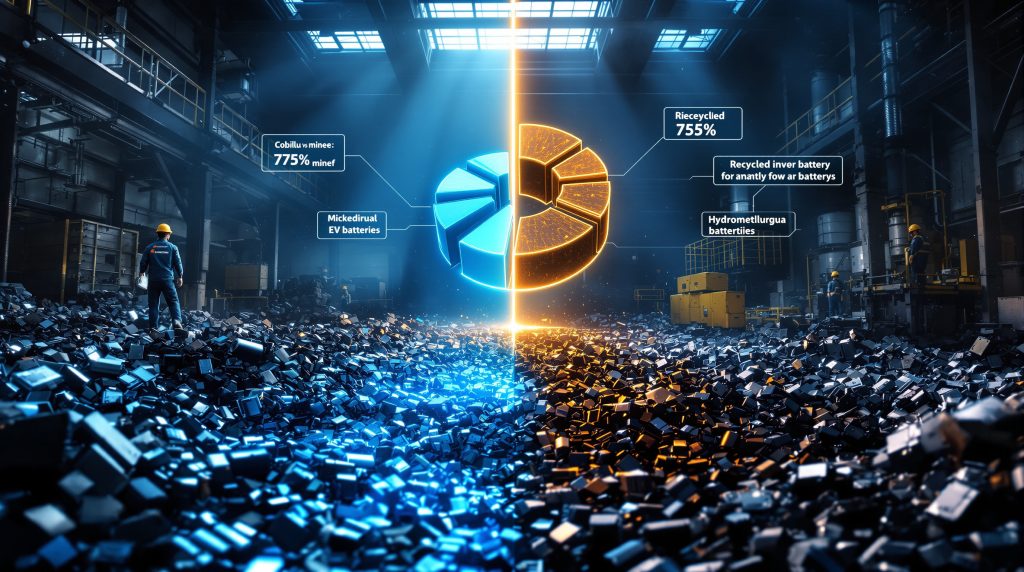Glencore's Battery Recycling Ambitions Falter Amid Leadership Shakeup
Battery recycling promised to be a cornerstone of the green energy transition, with mining giant Glencore positioning itself at the forefront of this emerging industry. However, recent events have upended the company's ambitious plans, highlighting the challenges facing even the most established players in this complex and evolving sector.
Strategic Expansion Meets Reality Check
Glencore made its significant move into the battery recycling sector in 2022, betting big on the future of electric vehicle battery materials recovery. The centerpiece of this strategy was a substantial investment in Li-Cycle, a once-promising battery recycling startup that had captured investor imagination with its innovative approach to recovering valuable metals from spent lithium-ion batteries.
The partnership initially seemed logical: Glencore brought mining expertise and global reach, while Li-Cycle offered cutting-edge recycling technology. However, this relationship has now unraveled, culminating in a leadership transition as Kunal Sinha, who spearheaded the initiative, departed after unwinding the troubled Li-Cycle partnership.
In his place, Ajay Kochhar joined Glencore in August 2025 as the new head of battery recycling, tasked with salvaging what remains of the company's recycling ambitions. Kochhar faces the challenge of redefining Glencore's approach in a sector that has proven more difficult to conquer than anticipated.
Financial Consequences of a Failed Investment
The financial toll of Glencore's battery recycling misadventure has been substantial. The company holds $327.5 million in outstanding convertible notes to Li-Cycle, representing a significant financial commitment that has failed to deliver expected returns. While Glencore has acquired Li-Cycle's key industrial assets and technology portfolio following the bankruptcy, the question remains whether these assets can be effectively integrated into a viable business model.
This financial setback highlights the risks of early investment in emerging technologies, particularly in capital-intensive industries like battery recycling where commercial viability remains unproven at scale. For shareholders, the Li-Cycle investment represents a costly lesson in the pitfalls of ambitious diversification strategies without sufficient technological and market validation.
Li-Cycle: From Market Darling to Bankruptcy Court
The Rise and Fall of a Recycling Pioneer
Li-Cycle's journey epitomizes the volatile nature of clean technology investments. The company's shares rallied strongly in 2021 as investors eagerly backed what appeared to be a promising solution to the looming challenge of battery waste. At its peak, Li-Cycle's market valuation reflected optimism about both its technological approach and the anticipated growth of the battery recycling market.
The company outlined ambitious plans to construct five recycling plants strategically positioned to process the growing volume of lithium-ion battery waste. These facilities would implement Li-Cycle's proprietary hydrometallurgical process to recover valuable metals like lithium, cobalt, and nickel from discarded batteries, producing what the industry calls "black mass" – a shredded form of metals extracted from old batteries.
However, these plans began to unravel in 2023 when construction of the company's flagship Rochester, New York plant was halted due to significant cost overruns. This setback marked the beginning of Li-Cycle's downward spiral, culminating in its bankruptcy filing in May 2025 amid insurmountable funding challenges.
Technical Hurdles in Battery Recycling
Li-Cycle's difficulties weren't solely financial; they also reflected the technical complexities inherent in battery recycling breakthrough. The company's approach centered on a two-stage process:
- Mechanical processing – Breaking down batteries and separating components
- Hydrometallurgical recovery – Chemical extraction of valuable metals
While conceptually sound, scaling these processes from laboratory to commercial levels proved significantly more challenging than anticipated. Issues related to processing efficiency, metal recovery rates, and handling variable battery chemistries complicated Li-Cycle's operations. These technical challenges contributed to escalating costs and delayed timelines, ultimately undermining the economic viability of the company's business model.
Industry experts note that battery recycling faces unique technical obstacles compared to traditional metal recycling, requiring more sophisticated processing techniques and higher capital investments to achieve economically viable recovery rates.
Industry-Wide Challenges in Battery Recycling
Market Timing Miscalculations
The battery recycling sector has become fiercely competitive as companies position themselves ahead of an anticipated surge in scrap supply expected from the 2030s onward. This forward-looking approach, while strategically sound in principle, has created a fundamental market imbalance: current processing capacity significantly exceeds available battery waste volumes.
This timing mismatch creates economic challenges for recyclers who must:
- Maintain expensive facilities operating below optimal capacity
- Compete aggressively for limited feedstock volumes
- Sustain operations through an extended period of negative cash flow
- Demonstrate viability to increasingly skeptical investors
As one industry observer noted, "The battery recycling industry is experiencing the classic 'too much, too soon' problem. Companies have built capacity for a wave of materials that won't arrive for several more years."
Britishvolt's Parallel Failure
Glencore's recycling setbacks parallel its troubled investment in Britishvolt, the UK battery manufacturer that filed for bankruptcy in 2023. Described as an "early casualty in Europe's crowded effort to boost EV-battery production," Britishvolt's collapse highlighted the challenges facing ambitious new entrants in the battery value chain.
The Britishvolt investment represented another aspect of Glencore's strategy to position itself within the electric vehicle supply chain. Its failure, alongside the Li-Cycle debacle, raises questions about the mining giant's ability to successfully diversify beyond its traditional strengths in resource extraction and trading.
These parallel failures also underscore broader concerns about Europe's battery production ambitions and the region's ability to compete with established Asian manufacturers who benefit from greater scale, experience, and integration.
Implications for Global Battery Metal Supply Chains
Recycling's Evolving Role in Metal Supply
Battery recycling remains a critical component of future metal supply projections, despite current setbacks. As electric vehicle adoption accelerates globally, the volume of end-of-life batteries will inevitably increase, creating both an environmental necessity and economic opportunity for effective recycling solutions.
Industry forecasts suggest recycled materials could provide:
- Up to 25% of lithium demand by 2040
- Nearly 40% of cobalt requirements
- Approximately 30% of nickel needed for batteries
However, these projections depend on the development of economically viable recycling technologies and supportive regulatory frameworks. The current challenges facing companies like Li-Cycle may delay but are unlikely to derail this transition toward a more closed-loop recycling approach.
Consolidation Reshaping the Competitive Landscape
Glencore's acquisition of Li-Cycle's industrial assets and technology portfolio in August 2025 exemplifies an emerging trend of consolidation within the battery recycling sector. This pattern of larger, well-capitalized companies absorbing technology and assets from failed startups may ultimately strengthen the industry by:
- Concentrating intellectual property and technical expertise
- Aligning recycling capacity with realistic market development timelines
- Integrating recycling operations with broader metal processing capabilities
- Providing financial stability through cyclical market conditions
This consolidation trend suggests that while the battery recycling industry will eventually mature into a critical component of the clean energy ecosystem, the path forward may favor established metals companies with diversified revenue streams rather than pure-play recycling startups.
Glencore's Path Forward in Recycling
Strategic Pivot Options
Following these setbacks, Glencore must recalibrate its recycling strategy to align with market realities while leveraging its core strengths. The company has several potential pathways forward:
-
Technology integration – Incorporating Li-Cycle's acquired technology with Glencore's existing metallurgical expertise to develop more cost-effective recycling processes
-
Phased capacity expansion – Matching recycling infrastructure development more closely with projected battery waste volumes
-
Leveraging traditional strengths – Building upon Glencore's established recycling capabilities in copper and lead while gradually expanding into lithium-ion battery recycling
-
Strategic partnerships – Collaborating with battery manufacturers and automakers to secure preferential access to end-of-life batteries
The proposed conversion of Glencore's lead smelter in Italy represents one potential avenue for strategic realignment. Li-Cycle had planned to transform this facility into Europe's largest producer of black mass, though this plan awaits approval from local authorities. Whether Glencore will proceed with this project under new leadership remains uncertain.
Industry Lessons from Glencore's Experience
Glencore's battery recycling challenges offer valuable lessons for the broader industry:
- Timing is critical – Aligning investment and capacity expansion with realistic market development timelines
- Technical validation – Ensuring recycling technologies are sufficiently proven before large-scale deployment
- Integration advantages – Leveraging connections with existing metal trading and processing operations
- Financial discipline – Maintaining sustainable cash flow during extended market development periods
These lessons will likely influence how other major mining and metals companies approach the recycling sector, potentially leading to more measured, phased approaches to capacity expansion and technology deployment.
FAQ: Battery Recycling Industry Outlook
When will battery recycling become economically viable at scale?
Most industry experts predict battery recycling will reach economic viability at scale in the early 2030s, when the first significant wave of electric vehicle batteries reaches end-of-life. Several factors will influence this timeline:
- Battery lifespan – Most EV batteries have 8-12 year operational lifespans
- Collection infrastructure – Development of efficient battery collection systems
- Processing efficiency – Improvements in metal recovery rates and cost reduction
- Regulatory frameworks – Implementation of extended producer responsibility legislation
Regional variations will persist, with markets like China likely achieving economic scale sooner due to earlier and more aggressive EV adoption rates.
How does battery recycling compare to traditional metal recycling?
Battery recycling presents unique challenges compared to traditional metal recycling:
| Aspect | Traditional Metal Recycling | Battery Recycling |
|---|---|---|
| Complexity | Relatively homogeneous materials | Multiple chemistries and components |
| Processing | Primarily mechanical/thermal | Mechanical, thermal, and chemical |
| Hazards | Limited chemical risks | Fire risks, toxic chemicals |
| Value Recovery | 80-95% for bulk metals | 70-85% for critical battery materials |
| Capital Intensity | Moderate | High |
The additional complexity of battery recycling necessitates more sophisticated technology and higher capital investment, contributing to the challenges faced by early market entrants.
What regulatory factors will shape battery recycling?
Several regulatory developments will significantly influence the battery recycling landscape:
- Extended producer responsibility (EPR) laws requiring manufacturers to manage end-of-life products
- Recycled content mandates establishing minimum percentages of recovered materials in new batteries
- Landfill bans for lithium-ion batteries due to fire risks and resource conservation
- Standardization efforts to improve battery design for recyclability
- International waste shipment regulations governing cross-border movement of battery waste
These regulatory frameworks vary significantly by region, with the European Union currently implementing the most comprehensive battery recycling legislation through its Battery Directive and Circular Economy Action Plan.
Which companies are better positioned to succeed in battery recycling?
Companies with certain characteristics appear better positioned to weather current challenges and succeed in the long term:
- Vertical integration across the battery value chain, providing secure feedstock access
- Diversified revenue streams reducing dependency on recycling operations during market development
- Established metallurgical expertise in processing complex materials
- Strong balance sheets capable of sustaining operations through extended commercialization periods
- Regulatory compliance capabilities to navigate complex and evolving waste management regulations
Established metals processors with existing recycling operations may hold advantages over pure-play recycling startups due to their ability to leverage existing infrastructure, technical expertise, and customer relationships.
Battery Recycling Market: Current State and Future Outlook
The battery recycling market remains in its early development stages, characterized by significant investments in capacity that currently exceed available feedstock volumes. While current challenges have tempered short-term expectations, the long-term fundamentals driving industry growth remain intact.
Key market dynamics include:
- Current overcapacity creating competitive pressure on early market entrants
- Technology innovation continuing despite commercial setbacks
- Regulatory frameworks evolving to support higher recycling rates
- Increasing corporate commitments to circular economy principles
"The battery recycling industry is going through the typical growing pains of an emerging technology sector. Current setbacks reflect timing and scaling challenges rather than fundamental flaws in the recycling concept." – Battery industry analyst
As the industry matures, successful participants will likely be those who can weather the current market development phase while positioning themselves for the anticipated surge in battery waste volumes in the 2030s. Glencore's experience serves as both a cautionary tale and potential blueprint for navigating the complex journey toward a circular battery economy.
For investors and industry stakeholders, the battery metals investment sector requires patience and a long-term perspective that aligns with the lifecycle of the products being recycled. Despite current challenges, recycling remains an essential component of sustainable battery supply chains and will play an increasingly important role as the critical minerals transition continues to accelerate with a growing emphasis on sustainable mining transformation.
Ready to Capitalise on the Next Major Resource Discovery?
Stay ahead of the market with Discovery Alert's proprietary Discovery IQ model, which provides real-time notifications of significant ASX mineral discoveries before they make headlines. Visit our discoveries page to see how early identification of breakthroughs like those discussed in this article could transform your investment portfolio.




